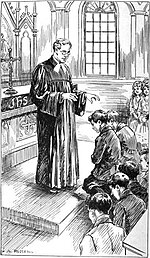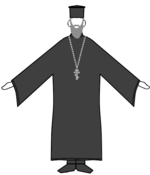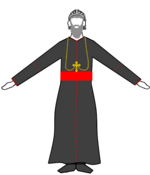Vestment
Vestments are liturgical garments and articles associated primarily with the Christian religion, especially by Eastern Churches, Catholics (of all rites), Lutherans, and Anglicans.In the early Christian churches, officers and leaders, like their congregations, wore the normal dress of civil life in the Greco-Roman world, although with an expectation that the clothing should be clean and pure during holy observances.Having separate, consecrated clothing for the ceremonies and rites in the churches emphasized the sacred nature of the functions the priest and ministers carried out at the altar.This ordinary wear does not constitute liturgical vestment, but simply acts as a means of identifying the wearer as a member of the clergy or a religious order.Among the Paleo-Orthodoxy and Emerging Church movements in Protestant and evangelical churches, which includes many Methodists and Presbyterians, clergy are moving away from the traditional black Geneva gown and reclaiming not only the more ancient Eucharist vestments of alb and chasuble, but also cassock and surplice (typically a full length Old English style surplice which resembles the Celtic alb, an ungirdled liturgical tunic of the old Gallican Rite).Prelates will also wear a Batrashil or Pallium (similar to an Epitrachelion but reaching down in both front and back) as well as Pectoral Icons.In addition, they will have a vestment similar to the Epigonation worn attached the Zenoro on the right side (called a Sakro) and will carry a crosier and hand cross.




























clerical clothingElevationchaliceliturgicalChristianEastern ChurchesCatholicsLutheransAnglicansReformed (Calvinist) ChurchescontroversyProtestant ReformationOrigins of ecclesiastical vestmentsGreco-Roman worldReformationCalvinismChurch of EnglandcontroversiesLutheranismChurch of Swedenrubricsclerical collarcassockreligious ordersreligious habitHoly EucharistHoly Communionchoir dressDaily OfficesanctuaryGeneva gownpreaching bandspreaching scarfActa Eruditorumvesting prayersCatholic clergychasubledalmaticbirettaEucharistWestern ChurchLatin ChurchBenaki MuseumDeaconspriestsbishopscincturecassock-albPectoral crossindultSurpliceRochetchimerecanonsZucchettokippahabbotsManipleTridentine MassAnglo-CatholicHumeral veilmonstrancesubdeaconTuniclesubdeaconschasuble-albcelebrantdeaconPalliumMetropolitan bishopsArchbishopsRationaleEichstättPaderbornKrakówBishopric of RegensburgPontifical glovesPontifical Solemn MassPontifical sandalsliturgical colormozzettaPontifical High MassesPapal tiaracoronationUrbi et OrbiSubcinctoriumagnus deiwaistcoatGaitersCanterbury capTippetreadersAcademic GownGenevaWilliam LaudLaudianismAcademic HoodPaleo-OrthodoxyEmerging ChurchMethodistsPresbyteriansCelticGallican Ritedikirion and trikirionCherubikonArchbishop John (Maximovich)mantleEastern OrthodoxByzantineEastern CatholicDivine LiturgyclergyawardspresbytersSticharionEpitrachelionEpimanikiaPhelonionNabedrennikKalimavkionEpigonationOrarionpanagiasymbolicOld TestamentPsalms